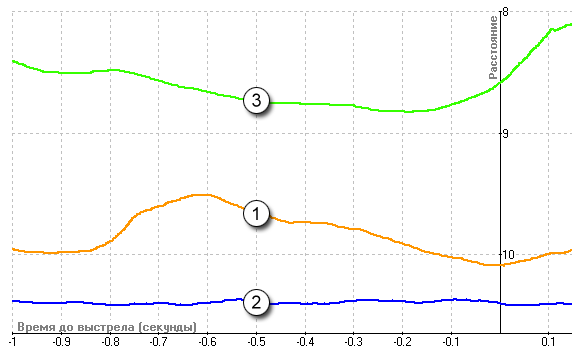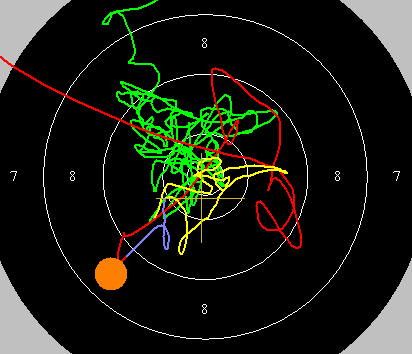Особенности анализа координации стрелка-спортсмена
На графике Координация по оси Х отмечено время равное 1 секунде до момента выстрела, по оси У отклонение от центра мишени, а кривая показывает среднее отклонение всех траекторий прицеливания от центра мишени.
Анализ кривой позволяет определить уровень мастерства стрелка, а также его подготовленность в данный период времени.
Кривая может быть трех видов:

- С плавным снижением перед моментом выстрела
- Горизонтальная
- С повышением перед моментом выстрела
Первый и второй варианты, как правило, говорят о том, что стрелок находится в хорошей форме и тренировка проведена успешно, правда, здесь не надо забывать об отклонении линии от центра мишени. У новичков часто можно увидеть плавно снижающуюся или горизонтальную линию, но она достаточно далека от центра и поэтому нельзя это считать большим достижением. Третий вариант, где кривая перед выстрелом немного поднимается, информирует спортсмена и тренера о наличии проблем в заключительной фазе выстрела или, проще говоря, оружие у стрелка перед выстрелом уходит из точки прицеливания.
На графике координации начало подъема кривой почти всегда находится в зоне 0,3-0,2 секунды перед выстрелом. Это связано со временем физиологической реакции человека. При наведении оружия в мишень стрелок, уточнив прицеливание, принимает решение и дает команду пальцу на нажим. Так вот с момента принятия решения до выстрела проходит время равное 0,2 – 0,3 секунды. Это также хорошо мы видим на мишени при простейшем анализе траектории прицеливания.

На данном примере траектория прицеливания за 0.2 секунды до выстрела выделена синим цветом, а за 1 секунду желтым. Наглядно видно, что в период от 1 сек до 0.2 сек перед выстрелом стрелок достаточно уверенно держит в центре, но за 0.2 сек оружие уходит из точки прицеливания.
Это проблема №1 в стрелковом спорте. С ней приходится сталкиваться абсолютно каждому стрелку, начиная от новичка до Олимпийского чемпиона. При опросе спортсмен обычно жалуется на то, что не давит палец на спуск или спуск тяжелый. Также можно услышать, что устойчивость отличная, но в момент выстрела оружие уходит из центра. Основная причина такой ошибки – это потеря контроля за удержанием.
Во время выстрела стрелок должен концентрировать внимание на трех элементах: ПРИЦЕЛИВАНИЕ , НАЖИМ ПАЛЬЦЕМ НА СПУСК и УДЕРЖАНИЕ ОРУЖИЯ. Но, как известно из физиологии и психологии, человек не может одновременно эффективно концентрировать свое внимание на нескольких действиях одновременно. Успешно это можно делать, контролируя один элемент, несколько хуже два и совершенно невозможно контролировать 3 и более элементов. В стрельбе у нас как раз такой вариант – 3 элемента. Перед выстрелом стрелок все свое внимание концентрирует на ПРИЦЕЛИВАНИИ и УДЕРЖАНИИ после уточнения прицеливания он принимает решение НАЖАТЬ НА СПУСК, но объема внимания не хватает и он вынужден часть внимания снять с ПРИЦЕЛИВАНИЯ или УДЕРЖАНИЯ и перебросить на СПУСК и, чаще, всего это внимание сбрасывается с УДЕРЖАНИЯ оружия и мы в итоге имеем неточный выстрел.
Для лучшего понимания данной проблемы и нахождения путей решения, рассмотрим эти три элемента по отдельности.
Удержание – данный элемент во всех случаях имеет приоритет. Держать оружие нужно перед выстрелом, в момент выстрела и после выстрела.
Прицеливание и нажим на спуск – эти два элемента чаще всего вызывают споры и разногласия. Ответ о том, какой из них более приоритетный дает физиология. При концентрации внимания на мышцах исполнителях (палец) время реакции составляет в среднем 0.2 секунды, а при концентрации внимания на сенсорных системах (прицеливании) 0.3 секунды.
В восьмидесятые годы в сборной команде СССР по стрельбе проводился эксперимент, суть которого была в следующем.
На экране монитора был циферблат, по кругу, которого бегал светящийся зайчик. Требовалось кнопкой остановить этот зайчик строго на отметке 12 часов. Результаты теста были следующие:
- 10-15 попаданий из 100 при концентрации внимания на экране монитора.
- 25-35 попаданий из 100 при концентрации на нажиме пальцем.
Данный эксперимент окончательно расставил приоритеты, НАЖИМ НА СПУСК всегда будет более важен, чем ПРИЦЕЛИВАНИЕ.
Из того, что было описано выше можно сделать вывод, что во время выполнения выстрела внимание должно доминировать на УДЕРЖАНИИ и НАЖИМЕ НА СПУСК, а ПРИЦЕЛИВАНИЕ должно находится под пассивным контролем.
При соблюдении последнего удается избежать потери контроля УДЕРЖАНИЯ на заключительной фазе выстрела.
При анализе этой проблемы заранее хотелось бы предостеречь от наиболее распространенной ошибки. Тренер, увидев, что благоприятный момент для выстрела находится за 0.3 секунды до выстрела, рекомендует делать выстрел немного раньше. Но это не дает эффекта, т.к. не устранена главная ошибка - потеря контроля над мышцами удерживающими оружие.
Поэтому, если вы видите, что линия на графике поднимается вверх, то главный вывод и рекомендация - контролировать удержание оружия до и в момент выстрела.
МСМК по пулевой стрельбе
Александр Куделин